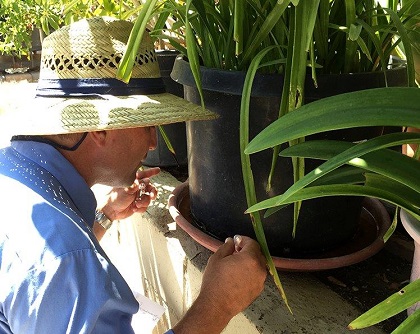Change the Zika Headlines; Don't Let Mosquitoes Grow
/
No doubt, you’ve seen the headlines — “County spraying,” “Zika virus,” “Invasive Aedes Mosquitoes.”
Four times in the last month, the County’s Vector Control Program has had to do something it’s never had to do before. It’s had to hike through people’s yards to spray and kill invasive Aedes mosquitoes to prevent them from coming into contact with, and potentially spreading, the Zika virus.
In four neighborhoods — South Park, Mt. Hope, Normal Heights and Grant Hill — the County had to spray to protect the public health. Because in each spot, a resident who was either suspected or confirmed of contracting the Zika virus outside of the country was living next to invasive Aedes mosquitoes — the vector that can spread Zika to other people if they bite an infected person.
The headlines might seem a little scary.
But there’s good news. And it involves you. See, you have the power to change the headlines.
Here’s all you have to do. Check around your home, your yard and your property and dump out any standing water to make sure mosquitoes don’t have any place they can breed.
If this sounds familiar, it should. It’s the “Prevent” part of the “Prevent, Protect, Report” guidelines the County has recommended for years to help people fight West Nile virus.
But it’s a message that has become more important because of these two invasive Aedes mosquitoes: the Aedes aegypti, or yellow fever mosquito, and the Aedes albopictus, the Asian tiger mosquito.
That’s because these Aedes mosquitoes really only want to breed in one place — right nextto you.
Not in a stream, a swamp or in a neglected green pool. Those are places where our native mosquitoes like to breed, the ones that can transmit West Nile virus to people. And that’s why County Vector Control has been able to use helicopters for years now to drop larvicide on 48 local waterways to help keep those mosquito populations down, and West Nile virus in check.
But the invasive Aedes mosquitoes prefer to live and breed next to people — in people’s homes and yards.
The invasive Aedes battleground is not in wide open spaces. It’s in your yard.
Now, you might be thinking, “I don’t have any standing water around my property.” But you might be surprised. Most mosquitoes can breed in small amounts of water. But Aedes mosquitoes can breed in the tiniest amounts of water.
How tiny? They can breed in a thimble. They can breed in that bottle cap that was dropped in your yard, within shot of your sprinklers.
So far this year, Vector Control officials — in the field and around their own homes — have found Aedes larvae growing in buckets, trash cans, landscape drains, leaky sprinkler boxes, rain barrels, ornamental garden lights, and in saucers under flower pots. They can also grow in pet dishes and inside toys collecting sprinkler water in your yard. One person even found them in her bromeliad — you know that Christmas cactus plant you see around the holidays? Larvae were growing in the folds of the plant!
Unlike the West Nile virus, which has been prevalent in our county’s environment since 2003, we don’t really have the Zika virus and tropical diseases like dengue and chikungunya here. That is, they don’t naturally occur here. We do get cases of them, mainly when county residents travel to other countries where the diseases do occur, get infected and then bring them home.
We’re also not supposed to have these invasive Aedes mosquitoes here either. They can transmit those tropical diseases by biting an infected person and then feeding on someone else. However, we started finding them in San Diego County in 2014. They are smaller than native mosquitoes, have distinctive black and white markings, are known as aggressive biters and — unlike our native mosquitoes that prefer to feed between dusk and dawn — like to bite and feed during daylight hours as well.
So now, when a local resident is suspected of having Zika, or confirmed as having Zika, we check around their home. If we find these invasive Aedes mosquitoes, our Vector Control folks go out and spray to kill the mosquitoes. The pesticide the County uses, Pyrenone 25-5, has been approved for use by the Environmental Protection Agency. It is derived from chrysanthemums, poses low risk to people and pets, and dissipates in roughly 30 minutes. Vector Control teams do wear protective gear and the County provides people in the spray areas with simple steps they can take to protect themselves.
The spraying goal is simple. Make sure no one else gets Zika by keeping the mosquitoes away from anyone who has the virus.
That’s why we’ve sprayed in those four neighborhoods, in South Park, Mt. Hope, Normal Heights and Grant Hill.
But you can change the headlines.
Police your home and your yard at least once a week. Dump out that water.
Don’t let those invasive Aedes mosquitoes grow!